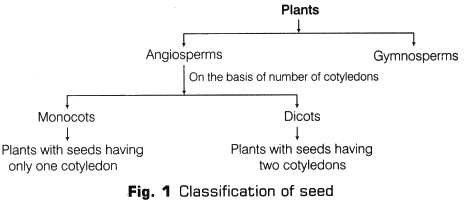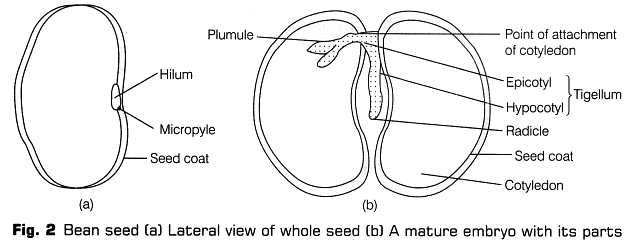Lab Manual: Dicot Seed - Class 10 PDF Download
Objective
To identify the different parts of an embryo of a dicot seed.Materials Required
Dicot seeds (gram, pea, rajma, etc), petri dish, forceps, needle, hand lens or dissecting microscope and cotton cloth/wool.
Theory/Principle
The SeedIn plants, the process of fertilisation leads to formation of fruits which is the ripened ovary. It contains seed (one or many) which is a mature ovule. A seed has following parts, i.e. a hilum, seed coat, an embryo and an endosperm. Hilum is the scar present on the seed coat, found attached to the plant stalk. Seed coat is the outer covering of the plant, it protects and nourishes the embryo present within the seed. The embryo is formed by multiple divisions of the zygote. It is an immature plant which grows when appropriate conditions are present.
An embryo contains following parts:
- A radicle: It forms the root system of the developing embryo.
- A plumule: It constitutes the embryonic shoot system, i.e. new shoots arise from the plumule.
- The cotyledons: The green, fleshy leaves of the embryo which forms the storehouse of nutrients especially proteins and starch for providing nutrients to the developing embryo.
Classification of Seed
On the basis of number of cotyledons present in a seed, the angiosperm plants are classified into two types (as shown in Fig. 1).
Dicot seed is attached by a scar like structure called hilum, to the inner line of the fruit. A pore like structure, micropyle is present at one end of the hilum. Through this pore, the seeds take up the water and under other favourable conditions like air, temperature and light, the seedlings develop into a small, immature embryonic plant from the seed coat. This process is called as germination.
The process of germination involves:
- Swelling of seeds and development of plumule into shoots.
- Roots start rising from the radicle of the seed.
- Cotyledons forms; one in case of monocots and two in case of dicots.
In angiosperms, a tissue called endosperm is present which also contains nutrients for growing embryo. On the basis of endospermic tissue, seeds are classified as:
- Endospermic seeds The presence of endosperm in mature seeds. Monocots have these seeds, e.g. wheat and maize.
- Non-endospermic seeds The absence of endosperm in mature seeds (because endosperm has been used during seed development). Dicots have such kind of seeds, e.g. pea and gram.
Procedure
- Take about 25-30 seeds of gram (Cicer arietinum).
- Soak these seeds in water for germination for 3-4 days by placing them on a moist cotton cloth.
- After 3-4 days, select a few well germinated seeds and place them in a petri dish.
- Swiftly select one seed and remove the seed coat using a forcep and a needle.
- Separate, very gently, the two parts of the seeds.
- Study the different parts of seeds, using a hand lens. In case of dissecting microscope, take the embryo out, place it in water and study its structure.
- Record your observations and make well labelled diagrams.
Observation
The germinating seeds when split open, showed following features:
- The gram seed has a brown coloured covering called seed coat (testa) which can be separated very easily from germinating seeds.
- A micropyle is found present at the grooved sides of the seeds. It is a pore, through which water enters the seed coat, thus starting the process of germination.
- Gently teased apart seeds will have an intact, small embryo, with sf radicle and a plumule emerging from it. A mature embryo appears as given in Fig. 2.

- The part present between the plumule and the radicle part of the embryo, i.e. the middle portion of the seed is called as embryonic axis or tigellum.
- The portion between plumule and the attachment point of cotyledons is known as epicotyl and the point between the radicle and the attachment point of cotyledons is called as hypocotyl. Thus the embryonic axis bears both epicotyl and hypocotyl.
- The cotyledons are broad, fleshy leaf-like structure of the seeds attached with embryonal axis, two in numbers (dicot). These are said to be the source of the reserve food materials necessary for the germination of seeds.
- The plumule and radicles form the shoot and root systems of the seed respectively, i.e. plumule give rise to shoots and radicle give rise to roots, thus developing into a new plant.
Result
On observation, two cotyledons were observed, hence the gram is a dicot seed. It is brown in colour and may be smooth or wrinkled in appearance. It contains a small embryonic plant within its seed coat. The embryo has plumule, radicle cotyledons (two in number) and tigellum.
Precautions
- Choose healthy seeds for the experiment.
- Before placing the seeds for germination, ensure appropriate availability of necessary conditions/requirements.
- Cloth used should be clean and moist.
- Use only properly germinated seeds.
- While opening the seeds, be gentle otherwise the embryo can break.



















